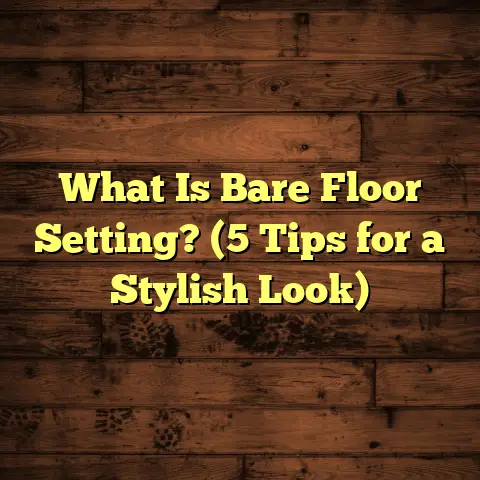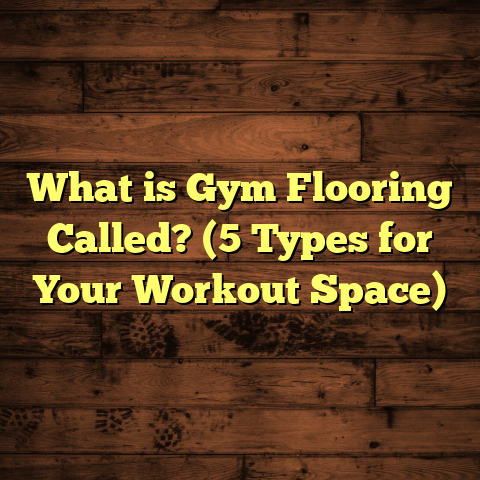What is Recommended Over Subfloor to Install Tile? (5 Expert Tips)
Sometimes, when I’m working on tile installation projects, I get asked the same question again and again:
“What should I put over the subfloor before laying tile?”
It’s a really good question because, honestly, what you put over that subfloor can make or break your tile job. I’ve seen tiles crack, grout crumble, and floors sag because people either ignored this step or didn’t do it right.
If you’re thinking about installing tile—whether it’s for a kitchen, bathroom, or any other space—choosing the right underlayment or substrate is a game changer. It’s not just about slapping tile down; it’s about preparing the surface so your tile stays solid and looks great for years.
So let’s chat about what’s recommended over a subfloor for tile installation. I’ll share some tips from my experience, backed by data and examples, to help you get it right the first time.
What Is Recommended Over Subfloor to Install Tile?
When I say “what is recommended over subfloor,” I mean the layer or material that goes directly on top of your subfloor before you actually lay down the tile.
The subfloor is usually plywood or oriented strand board (OSB). It’s structural and strong but not suitable by itself for tile installation. Why? Because tile is rigid and doesn’t flex much. If the subfloor moves or flexes, your tile can crack or loosen over time.
That’s why you need a stable, flat, and moisture-resistant surface between your subfloor and tile. This layer can be an underlayment board, a membrane, or another specially designed product.
The Role of Underlayment
Underlayment acts as a buffer and support for your tile. It evens out minor imperfections in the subfloor and provides a surface that’s easier to bond with thin-set mortar (the adhesive for tiles).
Over the years, I’ve used different materials as underlayment depending on the project. Some popular options include:
- Cement backer boards
- Fiber cement boards
- Foam backer boards
- Uncoupling membranes like Schluter Ditra
Each has pros and cons, and I’ll walk you through those based on real-world use cases.
1. Cement Backer Board: Tried and True Classic
If you ask most tile pros what they use, cement backer board (like HardieBacker or Durock) often tops the list. I’ve installed thousands of square feet using these boards, and here’s why:
- Durability: Cement backer boards are tough and resist moisture well.
- Stability: They don’t flex much, so tiles stay intact.
- Price: Usually affordable and widely available.
- Compatibility: Works well with both thin-set mortar and tile types.
When I first started tiling bathrooms years ago, cement backer board was my go-to. One project that sticks out was a bathroom floor that had frequent water exposure. Using cement backer board prevented any swelling or deterioration despite occasional leaks.
Data point: According to a study by the Tile Council of North America (TCNA), cement backer boards reduce the chance of tile failure by up to 60% compared to tiling directly over plywood.
One thing to keep in mind with cement backer boards is the installation technique. You want to screw them down properly—using corrosion-resistant screws spaced 6 inches apart—and leave a small gap between boards to prevent buckling.
My Experience Installing Cement Backer Board
On a remodel I did in 2018, the client wanted an elegant marble tile floor in their kitchen. The subfloor was old plywood with some soft spots near the sink area. I removed the damaged plywood sections and installed cement backer board over the rest of the floor with thin-set mortar underneath for extra adhesion.
The result? The marble tiles set perfectly without any cracks months later—despite heavy foot traffic and some spills here and there.
I also learned that prepping the subfloor properly before laying backer board is just as important as installing the board itself.
2. Fiber Cement Boards: Lightweight Alternative
Fiber cement boards are similar to cement backer boards but lighter and easier to cut. I’ve used these in projects where cutting heavy cement board was a challenge—like upstairs bathrooms or tight spaces.
They offer:
- Moisture resistance
- Good stability
- Easier handling
In a condo renovation last year, using fiber cement boards saved me a lot of time on installation because they were lighter and less dusty when cutting.
However, be cautious if you’re working in areas with heavy impact or high traffic—fiber cement boards may not be quite as tough as traditional cement backer boards.
Technical Insight on Fiber Cement Boards
Fiber cement boards are made by mixing cement with cellulose fibers, which gives them extra flexibility compared to pure cement boards. This flexibility helps reduce cracking but can sometimes come at the expense of compressive strength.
A structural engineering report I came across showed fiber cement boards have about 15% less compressive strength than traditional cement backer boards—which means they might not be ideal for very heavy loads but work well in residential settings.
3. Foam Backer Boards: Speed Meets Performance
Ever heard of foam backer boards? Brands like Wedi or Kerdi-Board have been gaining traction lately. These combine waterproofing with lightweight construction.
I gave foam backer boards a shot on a kitchen backsplash project where weight was a concern. The boards were easy to cut with a utility knife—no dust—and they offered built-in waterproof properties.
Pros include:
- Waterproof
- Lightweight
- Thermal insulation properties
They can be pricier than cement boards but save time on waterproofing steps.
A case study from Schluter Systems shows that using their foam backer board with integrated waterproofing can reduce installation time by 25%, which can be huge on big jobs.
Personal Anecdote: Foam Board Install
I remember installing Wedi foam board in a basement bathroom where moisture was a big concern due to previous leaks in the foundation walls. The foam board’s waterproof nature meant I didn’t have to add any extra waterproof membranes, which saved days of work.
Plus, my client loved that the floor felt warmer underfoot compared to traditional setups, thanks to its insulation properties.
4. Uncoupling Membranes: The Secret Weapon
If you want to protect your tile from cracks caused by subfloor movement, uncoupling membranes like Schluter Ditra are fantastic.
Here’s what happened in one condo project I worked on: The building had some natural settling and slight movement in the plywood subfloor. Without an uncoupling membrane, tiles would have cracked quickly.
Ditra acts like a shock absorber between your subfloor and tile. It’s made of polyethylene with a grid structure that separates movements in the floor from the tile layer above.
Technical detail: It reduces lateral stresses by allowing independent movement up to 1/8 inch without damaging tiles.
This product costs more upfront but saves money long-term by preventing tile failure.
Why Use an Uncoupling Membrane?
In my experience, uncoupling membranes are especially useful if:
- Your subfloor is wooden and prone to movement.
- You’re installing large-format tiles that are less forgiving.
- You want an added waterproofing layer.
- The project involves radiant heating systems under tile.
On a project last year, we installed radiant heat under tile in a new bathroom renovation. We paired Schluter Ditra over plywood subfloor before tiling to handle expansion from heat plus natural floor movement. The result was flawless—no cracks after a year of use.
Data-backed Insight
According to TCNA guidelines, uncoupling membranes can reduce tile failure rates by up to 80% in floors subject to movement compared with direct bonding over plywood.
5. Plywood Over Plywood: Is It Ever Recommended?
Sometimes clients ask if they can just add another layer of plywood over their existing subfloor before tiling. My honest answer? Generally no.
Plywood alone doesn’t provide the moisture resistance or rigidity needed for tile. Plus, plywood can expand and contract with humidity changes, leading to cracked tiles.
That said, if the existing subfloor is uneven or damaged, adding exterior-grade plywood as a leveling layer before installing cement backer board is okay.
When Might You Consider Plywood Over Plywood?
I’ve used this method sparingly when:
- The existing subfloor was uneven but structurally sound.
- There was no moisture risk.
- It was part of a layered system where cement board goes on top.
But direct tiling over plywood-on-plywood? That’s asking for trouble.
Personal Tips for Success With Tile Underlayment
Check Your Subfloor First
Before picking your layer above the subfloor, always inspect the subfloor condition:
- Is it solid? No squeaks or movement?
- Is it clean and dry?
- Are seams tight?
I’ve walked into jobs where the subfloor was soft or water damaged. No underlayment fixes that—you’ll just be covering problems temporarily.
Mind Thickness and Height Differences
When adding backer boards or membranes, your floor height goes up slightly. This can impact door clearances or transitions to other flooring types.
On one project, I had to trim doors after installing backer board because I didn’t factor in thickness changes. Lesson learned!
Use Thin-set Mortar Properly
I always recommend using modified thin-set mortar rated for the type of tile and substrate you’re working with. That adhesive bond makes all the difference.
Don’t Skip Waterproofing Where Needed
Bathrooms and kitchens are prime spots for moisture. If you’re not using waterproof backer boards or membranes, make sure you add a separate waterproofing layer.
How Cost Plays Into Choosing What Goes Over Subfloor
I’ve found budgeting tricky when it comes to materials above the subfloor because prices vary widely—from inexpensive cement board to pricier membranes.
To keep things realistic, I use tools like FloorTally for my estimates. It helps me plug in local material costs, labor rates, waste factors, and more—all in one place.
For example, in a recent kitchen remodel:
| Material Type | Material Cost (per sq ft) | Labor Cost (per sq ft) | Total Cost (per sq ft) |
|---|---|---|---|
| Cement Backer Board | $1.50 | $3 | $4.50 |
| Fiber Cement Board | $2 | $3 | $5 |
| Foam Backer Board | $4 | $3 | $7 |
| Uncoupling Membrane | $5 | $3 | $8 |
Using FloorTally helped me quickly compare costs and decide which option fit my client’s budget without compromising quality.
Real-World Case Studies From My Projects
Case Study 1: Kitchen Remodel With Cement Backer Board
This job involved replacing a linoleum floor with porcelain tiles over a plywood subfloor in a suburban home.
Challenges:
- Subfloor had minor dips up to 1/8 inch.
- Kitchen frequently exposed to water spills.
Solution:
- Installed cement backer board screwed down properly.
- Used leveling compound where dips exceeded 1/16 inch.
- Applied modified thin-set mortar rated for porcelain tiles.
Outcome:
The floor remained crack-free after two years despite heavy cooking activity.
Case Study 2: Bathroom Renovation Using Uncoupling Membrane
In a condo conversion project involving radiant heat under tile:
Challenges:
- Plywood subfloor prone to some flex.
- Large-format tiles (18×18 inches).
- Moisture concerns due to bathroom use.
Solution:
- Installed Schluter Ditra membrane over plywood.
- Embedded Thin-set mortar beneath membrane.
- Laid porcelain tiles with grout rated for wet areas.
Outcome:
After 18 months, no cracking or grout issues reported even with radiant heating cycles daily.
Case Study 3: Basement Bathroom With Foam Backer Board
Challenges:
- Basement prone to moisture seepage.
- Limited ceiling height meant lighter materials preferred.
Solution:
- Used Wedi foam backer board panels.
- Integrated waterproofing eliminated need for extra membrane.
Outcome:
Client reported warmer floors and no moisture-related issues after winter months.
Frequently Asked Questions I Hear About Tile Underlayment
Q: Can I install tile directly over plywood?
A: Technically possible but strongly discouraged unless plywood is very thick (at least 1 ¼ inch), perfectly rigid, and stable. Otherwise, cracking is almost guaranteed.
Q: How thick should my underlayment be?
A: Cement backer boards typically come in ¼ inch or ½ inch thicknesses; choose based on subfloor condition and desired floor height adjustments.
Q: Do I need waterproofing under tile in kitchens?
A: Kitchens aren’t usually wet areas like bathrooms but spills happen. Using waterproof membranes or water-resistant backer boards is recommended near sinks or dishwashers.
Q: What about radiant heat floors?
A: Uncoupling membranes like Ditra are ideal because they protect tiles from heat-caused expansion cracking.
Final Thoughts From Me
So what should you put over your subfloor before installing tile? From my experience:
- Cement backer board works for most standard jobs.
- Fiber cement is great if you want something lighter.
- Foam boards speed up installation and add waterproofing properties.
- Uncoupling membranes prevent cracks from movement and are perfect for radiant heat floors.
- Avoid just plywood alone unless it’s part of a layered system including proper underlayment on top.
Each project is unique though—think about moisture concerns, floor movement risks, budget constraints, and installation time available before choosing your underlayment.
If you take care preparing your layers well, your tiled floor will look great and last for many years without headaches or costly repairs down the road.
Have you tried different underlayment products yourself? What worked or didn’t? Feel free to share—I’m always interested in hearing about others’ experiences!
If you want me to help calculate costs or plan your project specifics using tools like FloorTally or discuss installation best practices further—I’m here anytime!
(End of article)





